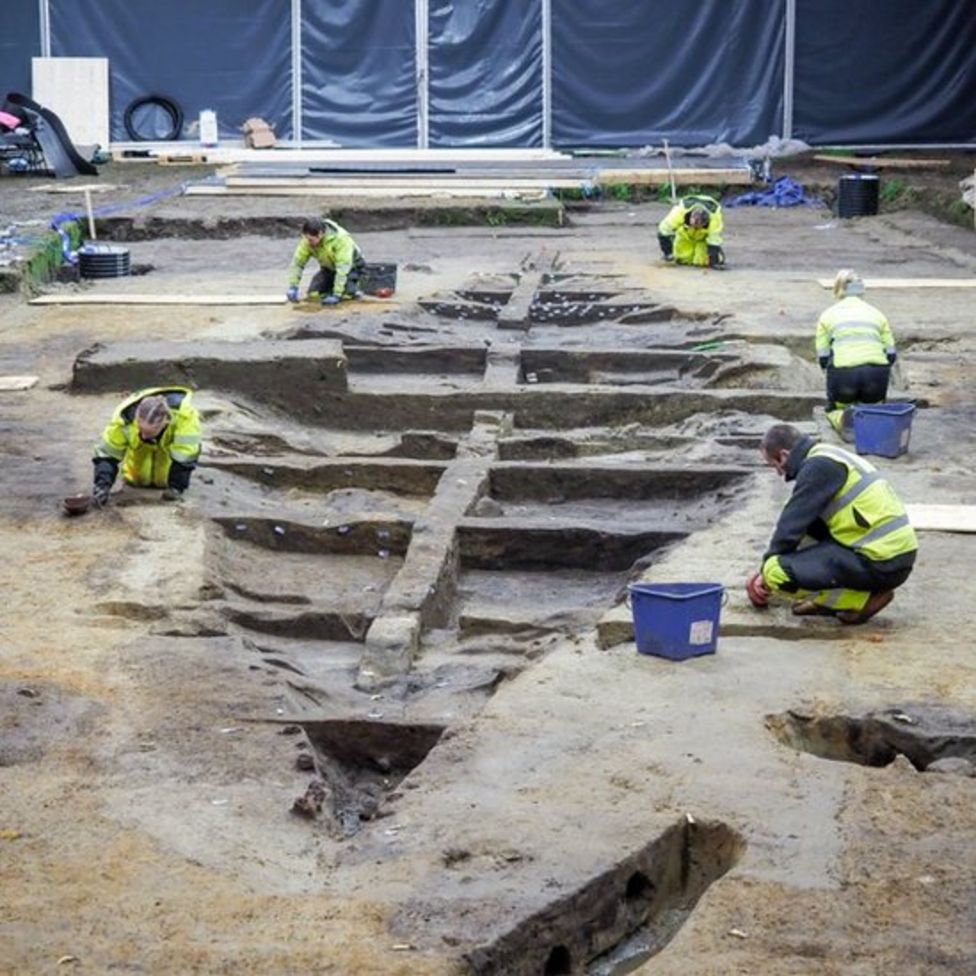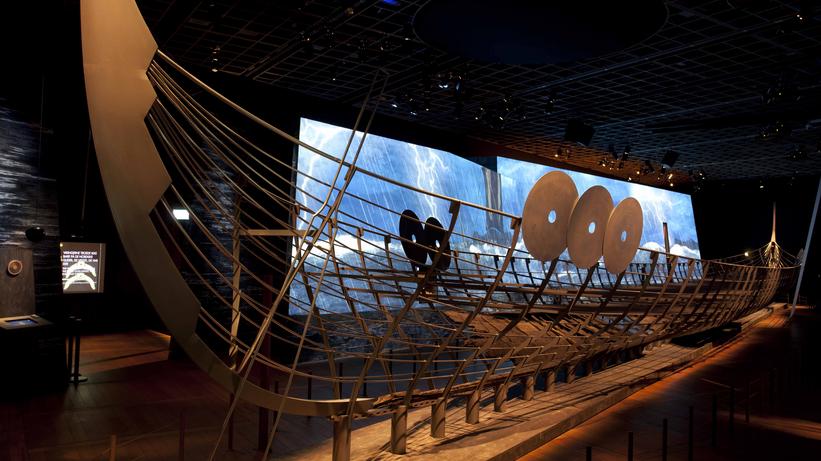



Source: Pixabay
The Vikings were talented seafarers, with their talents for shipbuilding and sailing taking them as far as North America. Learn more about their ships and exploration with the following resources.
The Viking ships, both the Longship and the merchant ship or ‘Knórr’, could equally well handle ocean voyages across the Atlantic. Neither needed a harbour, but could land on beaches or river banks anywhere. This article describes both of these ships and how they sailed.
Many Vikings were good sailors because they lived close to rivers and fjords (sea inlets). They grew up learning how to use ships for fishing and travelling. The Vikings built fast ships for raiding and war. In a raid, a ship could be hauled up on a beach and the men would jump out to fight. They could make a quick getaway if they were chased. A big Viking longship would be about 30 metres long and could carry 60 men. The men slept and ate on deck. When rowing, sailors sat on chests with their belongings in. They were made from planks of oak wood joined together. These overlapped each other, which made the ship very strong.
Pyramids, castles, palaces: symbols of power and status have taken many forms down the ages, and for the Vikings what really counted was the longship. In December 2020, Norwegian archaeologists hope to complete their excavation of a rare, buried longship at Gjellestad, an ancient site south-east of Oslo. It is the first such excavation in Norway for about a century. Most of the ocean-going ship has rotted away over the centuries, but archaeologist Dr Knut Paasche believes the layout of the iron nails will still enable a replica to be built eventually.
For three turbulent centuries, the glimpse of a square sail and dragon-headed prow on the horizon struck terror into the hearts of medieval Europeans. Indeed, the Viking Age, from A.D. 800-1100, was the age of the sleek, speedy longship. Without this crucial advance in ship technology, the Vikings would never have become a dominant force in medieval warfare, politics, and trade. This article looks at the different types of Viking ships and what made them so successful.
This shows looks at the arrival of one of the most fearsome and notorious warriors in Irish history – the Vikings. These Scandinavians have been caricatured throughout the centuries as marauding maniacs a somewhat undeserved reputation. However in this episode they don’t exactly cover themselves in glory. The show will reveal what drove people in Scandinavia to launch what were terrifying raids, how these raiders reached Ireland and then before the episode ends we will join them for their onslaught on Irish monasteries.
Melvyn Bragg and his guests discuss the Volga Vikings. Between the 8th and the 10th centuries AD, fierce Scandinavian warriors raided and then settled large swathes of Europe, particularly Britain, Ireland and parts of northern France. These were the Vikings, and their story is well known today. Far fewer people realise that groups of Norsemen also travelled east. These Volga Vikings, also known as the Rus, crossed the Baltic into present-day Russia and the Ukraine and founded settlements there. They traded commodities including furs and slaves for Islamic silver, and penetrated so far east as to reach Baghdad. Their activities were documented by Arab scholars: one, Ahmad ibn Fadlan, recorded that the Volga Vikings he met were perfect physical specimens but also "the filthiest of God's creatures". Through trade and culture they brought West and East into regular contact; their story sheds light on both Scandinavian and early Islamic history.
At some point early in the Viking Age, a group of Northmen came across a natural harbour on the western side of the Irish Sea. Being that they were a seafaring people, having places in foreign lands where they could safely make port was a significant advantage. Orkney was already showing its usefulness, and now they needed another waypoint further south. The life of a northman, even the life of a Viking, involved a lot more travelling and trading than it did actual raiding. So having friendly trading spots along their route wasn’t just convenient, it was good business.
The Baltic Sea, the North Sea and the North Atlantic were the Vikings’ super-highway. These are some of the world’s most difficult waters to sail upon, even with the Viking Ships. This article describes how the Vikings prepared for a journey, and how they navigated across the seas.
On most journeys the Vikings sailed along the coast so they could use the valleys and mountains as landmarks. This article describes how the Vikings navigated along the coast of Norway.
A list of the different tools the Vikings used to navigate.
Birka sits upon the island of Björkö at the entrance of the Mälar Sea (sometimes called Lake Mälar), not far from the site of modern Stockholm. Birka therefore acted as the trade center and gateway for all of Central Sweden. The major east-west trade route passed along the southern Swedish coastline, through Bornholm, Öland, and Gotland, but Birka was the richest trade center of all. Traders came to Birka from Frisia, Anglo-Saxon England, Germany, the Baltic countries, Greeks from Byzantium, and Orientals. The article includes maps of the settlement, along with a description of the history of the settlement.
Prior to the advent of written Scandinavian history, the Danes and Swedes were launching raids and settlements Eastwards across the Baltic. The reason for these warlike activities was wealth in the form of amber and furs which were looted or taxed from the Finns, Wends, Slavs, and others living in the eastern Baltic region. Russia itself was not subject to the swords of the Scandinavians except for scattered raids until ca. 850 AD.
This article talks about the Viking invasion of Ireland, and how the Irish viewed the Vikings.
A look at the raids, exploration and settlement by Viking Age Scandinavians in Scotland, Shetland, the Isle of Man, and the Faroes.
Article from National Geographic detailing further evidence of Viking settlement in North America, that prove the Norse settlers pre-dated Columbus by 500 years.


Clench nails were used in clinker-style ship-building from the 7th century to the 15th and also for domestic purposes, in which clench nails might appear where ship timber has been reused. Clinker ship-building involved building the ship’s hull first out of layered planks attached to the keel and held together using clench nails. Clinker-built boats and ships are particularly associated with the Vikings.

This coin was minted at al-‘Abbasiyya. The dirham was a unit of weight used across North Africa, the Middle East, and Persia, with varying values which also referred to the type of coins used in the Middle East during the Viking Age. These coins were extremely prized possessions not only for their silver value but as a way of displaying ones wealth and vast trade connections. Millions of Arabic Dirhams would have been imported throughout the Viking world and are mostly found in hoards. Reduction in access to silver coins like this is thought to have been one of the causes of the Viking Age.

In December 2020,
Norwegian archaeologists hope to complete their excavation of a rare, buried longship at Gjellestad, an ancient site south-east of Oslo. It is the first such excavation in Norway for about a century.
Most of the ocean-going ship has rotted away over the centuries, but archaeologist Dr Knut Paasche believes the layout of the iron nails will still enable a replica to be built eventually.
Ground-penetrating radar (GPR) revealed it to be about 19m (62ft) long and 5m (16ft) wide - putting it on a par with the well-preserved Oseberg and Gokstad Viking ships on display in Oslo.
Those ships were found on the western side of the wide Oslo Fjord.

When the Viking Ship Museum in Roskilde in 1996-97 had to expand and establish a new museum harbor, a fantastic find was made. No less than at least nine shipwrecks were hidden at the bottom of the fjord next to what was once Roskilde harbor.
The ships that made up Northern Europe's largest total shipwreck were generally well preserved, and among them lay a sensation waiting.
The oldest of the vessels turned out to be the longest Viking ship ever found. At 37 meters, it is a full seven meters longer than the second largest, Skuldelev 2. At the same time, it was of a quality that revealed its affiliation with the very top social strata of the Viking Age.
............


 Viking explorers
by
Viking explorers
by